After a period of partial obscuration, the last few years have seen the re-emergence, at an international level, of a decisive reinvigoration of painting, in particular of figure painting, perhaps in compliance with the well-known cliché according to which it is the most classic of safe havens in crisis times (such as those which are darkening the destinies of the world and of the western hemisphere in particular). In contrast to the immediately preceding period in which, visiting fairs and gallery exhibitions, we were visually congested by a sort of lightened reworking of the geometric abstractionism of the historical avant-gardes by the younger artists and by reassuring monochrome explorations of the pictorial surface, the human being seems to be now a ductile pictorial object to be liquefied, dismembered, hybridized or deformed.
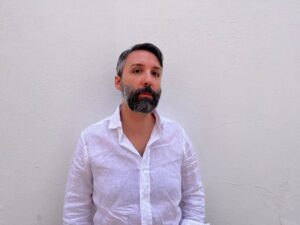
Domenico Russo, author of the book l’Altra Individualità. La pittura figurativa in Italia oggi (Silvana editoriale, 2023)
In this renewed centrality of the human figure, today far from triumphant compared to the period in which it was considered the most prestigious genre among the academic hierarchies of figurative art, new anxieties are insinuated. They come from the visual saturation triggered by the digital and an ever more ambiguous relationship with the body, in many cases perceived almost as a disturbing “other than oneself”. The book L’Altra Individualità. La pittura figurativa in Italia oggi (The Other Individuality. Figurative painting in Italy today) focuses on these issues. In the book the author Domenico Russo analyzes two generations of research starting from the poetics of some paradigmatic artists of what he identifies as a new current of Italian figurative painting, which he precisely labeled as «Other Individuality».
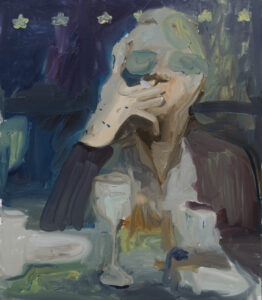
Rudy Cremonini, Fango e Paillettes, olio su lino, 80cm x 70 cm, courtesy Francesca Antonini
Arte Contemporanea
Emanuela Zanon: The intuition on which the thesis of your book is based was presented to the public in 2020 in the homonymous exhibition (co-curated by you together with Andrea Tinterri and Luca Zuccala) at State Of Milano. How did your reflection develop in the three years of gestation of the editorial project??
Domenico Russo: The reflection that led to the idea of the exhibition, and subsequently to its publication, was born some time before, from the acquaintance with some of the artists: following their work, I grasped that autonomous expressive force that allowed them to be seen and discussed today. In 2018, on the occasion of their double exhibition in Rome Il mangiarsi reciproco, I started writing about the artists Silvia Argiolas and Giuliano Sale, even then referring to them as leaders of what would later be discussed in the L’Altra Individualità, above all because of that painting so adhering to a communicative urgency that does not exclude social dangers and private impulses. This was precisely the vision from which the 2020 exhibition took shape, organized with Andrea Tinterri and Luca Zuccala, also including other artists who worked similarly. Unfortunately, the arrival of Covid has blocked the project on several occasions, but not the pictorial current itself which has not been scratched under the viral furies and government restrictions.
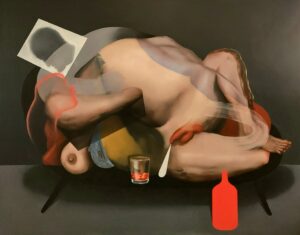
Giuliano Sale, Nice fuck with a negroni, cm 130 x 110, courtesy Collezione Giuseppe Demara
In an era marked by the dominance of virtuality and the multiplication of “fictitious egos” that derive from it, the artists who belong to this movement incorporate the anxieties of an exaggerated individualism, which is on the one hand increasingly self-referential, but on the other seeks a of recognition and subjectivation precisely in the otherness at the origin of the existential solitude. These artists seem to want to assume the social function historically assigned to art (today deeply in crisis) while maintaining it in an individualistic context: would you like to deepen this contradiction which seems to me particularly important in your text?
We are so caught up in ourselves and everything we have to do, short-term goals burn us daily and like torches scattered in the night we go out in the silence of a sea of realities that we cannot fully understand or grasp. Art, close skin, source without distances, launches lifeboats, sheds light on the truth by revealing intrigues and showing discrepancies, making the seabed visible. And thus altruist painting, a friend of reality, captures impalpable anachronisms and reacts to the amniotic fluid we slip into, that fat necessary to grease the mechanisms of those relationships that we cultivate smiling, deluding ourselves that we are satisfied. Precisely in this dense fluid the artists dip the tools to compose their visions, bringing the world back to the natural clarity of painting. Everything is brought back to the canvas and so the picture becomes a fearsome story of today, the trigger of a symbolization rounded off by drives coming from a private condition, placed in contrast with the social one. The individual and the community are brought into relationship. The figure is a measurement unit of the sentiment of an era, a refuge of one’s individuality, an individuality that should be felt as an intimate part of oneself to be placed in relationship with the other. L’Altra Individualità favors this relationship in a median space of meeting and exchange, where the altruist narration develops. The surface of the painting, on which the clear story takes place, sometimes suffered, not self-referential, neither cold nor detached, not decorative, is a channel between thought and people, between reality and the community, a healthy possibility of a symbolic place in where the individual charge is not lost but is accomplished in the pictorial word that brings together and unites.
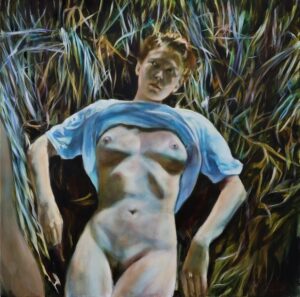
Iva Lulashi, Più pallida dell’erba, 2021, olio su tela, 70 x 70 cm
Another significant aspect of your reflections concerns the renewed emphasis, after artistic generations variously marked by quotation and sampling, on the need to create more than to rework. Do you think that this solicitation, as well as directing the mental elaboration of the subjects, has also resulted in a common stylistic feeling considered from a more technical point of view?
Somehow the free relationship with tradition and the tendency to narrate painting form the underlying glue for the different attitudes. The approaches to the canvas change and simultaneously make the other authors unique in their stories. In some cases different procedures involve more gestural, immediate or direct approaches like that of Rudy Cremonini who skilfully works first hand. In many works by Michele Bubacco, the use of photos and collages among masses of domesticated forms finds a painful connection with the applications and additions that sometimes fill the unfillable Silvia Argiolas or with the slippery backgrounds by Davide Serpetti, while Anna Capolupo extrapolates from personal reality dreamlike junctures and Agnese Guido deviates in imaginative animations. All of them, however, generally prefer temperas, inks, pigments to which mixed techniques – sprays, pencils, felt-tip pens, collages, pastels, fabrics, plasters and more – add heterogeneous elements to a deeply pictorial, classic essence, lost in its origins of man, timeless patrol in the streets of history, still absolutely pertinent today.
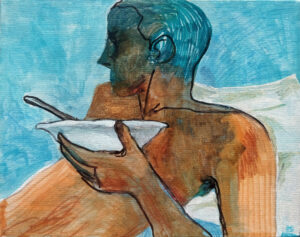
Matteo Nuti, Partita, olio, matite e pennarelli su tela, 24 x 30 cm, 2021, courtesy collezione Simona Bielli
The book explores the research of: Silvia Argiolas, Alessandro Pessoli, Giuliano Sale, Michele Bubacco, Rudy Cremonini, Giacomo Modolo. Which other artists would you refer to the L’Altra Individualità?
On the edge of the speech, at the source of the language, there is Alessandro Pessoli, initiator and fearless creator. His stature is an outline through which many artists have introjected their poetics. This is also why talking about him had become necessary. He is a kind of father to all artists, an inexhaustible dreamer who, with solitary excursions into sacred art and imaginative inspections of the contingent, has traced the common denominator to which the nucleus developed in the following generations who look at him with respect can be traced back. In addition to Argiolas, Bubacco, Cremonini, Modolo and Sale, among the brilliant stars of the night sky of the current we can find Irene Balia, Anna Capolupo, Agnese Guido, Thomas Berra, Iva Lulashi, Adriano Annino, Maurizio Bongiovanni, Nicola Caredda, Barbara De Vivi, Dario Carratta, Dario Maglionico, Andrea Fiorino, Alice Faloretti, Dario Molinaro, Matteo Nuti, Sophie Westerlind and other important names that surely escape me now.
.
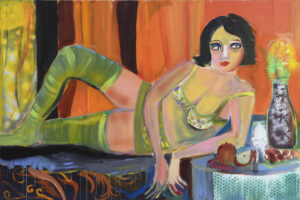
Silvia Argiolas, Una moglie, acrilico e smalto su tela, 120 x 150 cm, ph Giorgio Benni, courtesy galleria Richter Fine art
Do you see a similartrend also in the international arena? If yes, who could be its exponents?
Absolutely yes, social premises and artistic responses blow around the world almost everywhere like a wind of novelty. Although the temperature of the regions it travels changes, the force that generated it remains the same. In some parts it whips and flips, in other areas it travels as a light breeze to breathe. If I had to name a few, right off the bat, I would think of Emma Fineman, Flo Brooks, Christopeher Hartman, Kudzanai-Violet Hwai, Adriana Progano, Amanda Ba…
Info:
Graduated in art history at DAMS in Bologna, city where she continued to live and work, she specialized in Siena with Enrico Crispolti. Curious and attentive to the becoming of the contemporary, she believes in the power of art to make life more interesting and she loves to explore its latest trends through dialogue with artists, curators and gallery owners. She considers writing a form of reasoning and analysis that reconstructs the connection between the artist’s creative path and the surrounding context.


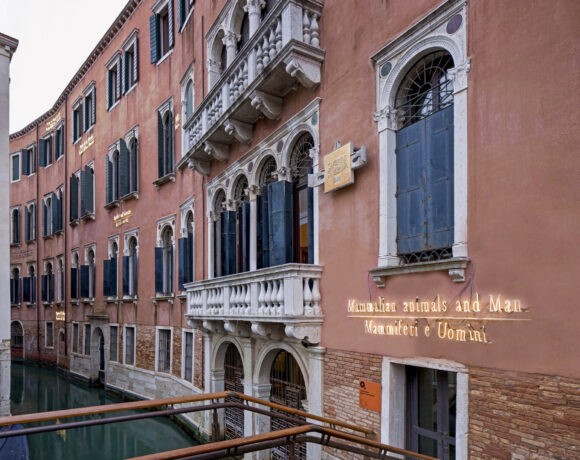
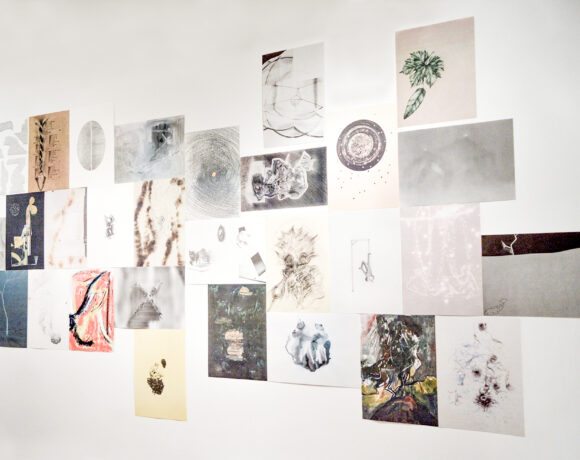
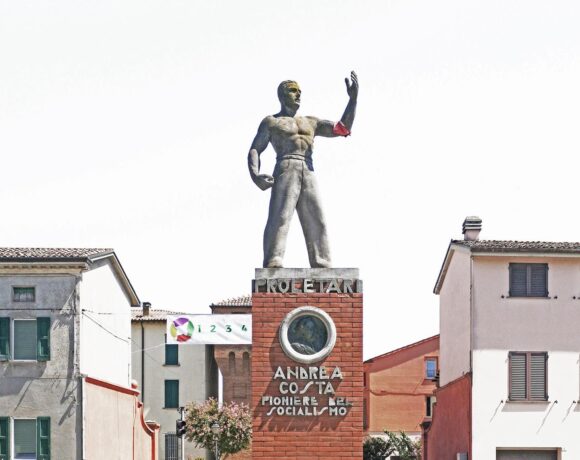

NO COMMENT